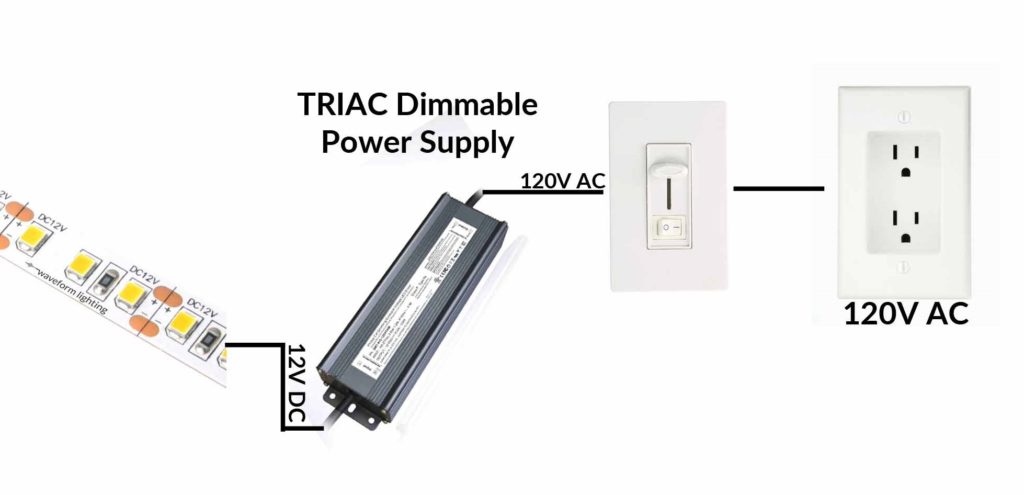

- #120v dimmer for led lights generator#
- #120v dimmer for led lights driver#
- #120v dimmer for led lights series#
If the PWM duty cycle is higher ( 100 ~255) then LED will turn ON but the brightness variation is not observed. If the frequency is above 5Khz and if the PWM duty cycle is lower( ex: <70) then the IGBT will get chance to turn on for very short time in each AC cycle. As the frequency increases the PWM pulse period decreases. When tested with AC 230V LED there is no significant difference in brightness as said earlier.ġ. So there is no issues with PWM signal generation w.r.t freq and duty cycle. I did check the PWM signal, it is varying and also when connected 5mm LED there is variation in brightness. The secondary side of the transformer produces the stepped down voltage which is rectified by a single diode and a large filter capacitor. We know that an LED bulb circuit is nothing but a small AC to DC SMPS circuit, which employs a small ferrite transformer for stepping down the mains voltage to a lower LED DC voltage.
#120v dimmer for led lights series#
However, the dimming effect can be perhaps implemented by connecting the series LED section of the LED bulb with the IC 555 circuit, as indicated in the following diagram: This means that dimming an LED bulb through an external means can be impossible. This filter capacitor will hold the charge and keep the LED bulb ON even during the OFF times of the PWMs, preventing the dimming effect. If you have any concerned question regarding the above explained dimmer circuit for LED bulb, you can express them through your comments.Ī deeper inspection of the above concept shows that the concept might not work due to the presence of the internal filter capacitor in every LED bulb circuit, right after the bridge rectifier. The circuit is not isolated from mains despite of the opto coupler due to fact that the IC 555 requires a DC supply for operating which is supplied from anon-isolated transformerless power supply, this is done in order to keep the design compact and avoid the use of costly SMPS module which could have been otherwise an overkill. The PWM control is executed through the associated 100K pot, which must be suitably insulated, as the whole circuit is not isolated from mains current. The connected LED bulb now responds to the PWM content applied by the 555 circuit and proportionately adjusts its brightness as per the user preference.

The adjustable PWMs are appropriately processed by the IC through its built in zero crossing detector circuit and photo triac which is ultimately used for controlling an external triac BT136 via its output pin#4/6.
#120v dimmer for led lights generator#
The IC 555 is configured as a standard adjustable PWM generator which feeds the desired PWM to the input pin#1/2 of the MOC IC. The right side of the figure comprises a standard MOC3063 IC based triac controller circuit which is operated through an IC 555 based PWM circuit shown at the left side of the figure. The idea is actually very simple, thanks to the MOC series opto couplers which make triac control through PWM extremely easy and compatible. The figure shows the design may be implemented. The best method and probably the technically correct approach is the PWM technology which can be effectively used for controlling or dimming LED bulbs or tubes.

If used then the LED bulbs do not dim correctly rather show erratic dimming or brightening behavior, due to an incompatible reaction.
#120v dimmer for led lights driver#
LED bulbs come with a built in SMPS driver within their holder cabinet, and an SMPS circuit makes it difficult to operate or control through a triac dimmer switches, until and unless its suitably modified for the application.īecause, the SMPS driver inside LED bulbs and tubes strictly employ inductor or capacitive based circuits which are never recommended to be used through triac dimmers, since triac dimmers utilize phase chopping technology for the dimming purpose which unfortunately does not suit inductive/capacitive load control. However with the advent of LED bulbs and tubes, incandescent bulbs are slowly making an exit, and our home bulb holders are getting replaced with LED bulbs. We know that our ceiling fans and incandescent bulbs can be easily controlled using triac dimmer switches, and we are quite used to with dimmer switches in our homes installed for controlling such devices.


 0 kommentar(er)
0 kommentar(er)
